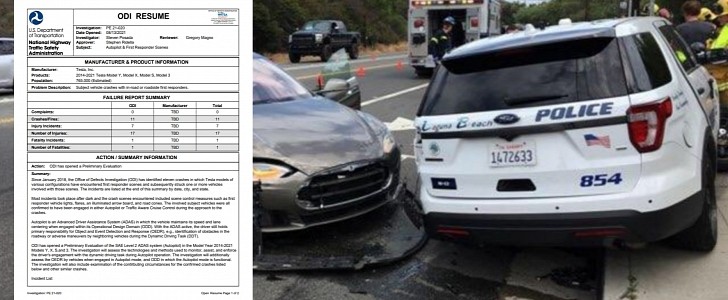NHTSA (National Highway Traffic Safety Administration) has been accused multiple times of being too soft on Tesla. It has opened 27 investigations about Tesla, 19 of which related to Autopilot. Two of them were concluded, leaving us with 25 inquiries, 18 related to Autopilot until now. NHTSA opened another investigation, this time related exclusively to crashes against emergency vehicles in which Autopilot was indeed activated.
The ODI (Office of Defects Investigation) identified 11 crashes between Tesla vehicles and first responders, which caused 17 injured people in 7 injury incidents and 1 dead. All of these crashes happened only from January 2018 up until now. The investigation report puts all Tesla vehicles made since 2014 under scrutiny. According to the agency, that means 765,000 Model S, Model X, Model 3, and Model Y units.
The main focus of the investigation is to “assess the technologies and methods used to monitor, assist, and enforce the driver's engagement with the dynamic driving task during Autopilot operation.” The conclusions may extend to all other incidents with Autopilot that did not involve emergency vehicles.
Other objectives of the inquiry are to “assess the OEDR (Object and Event Detection and Response) by vehicles when engaged in Autopilot mode, and ODD (Operational Design Domain) in which the Autopilot mode is functional.”
The document stressed that “most incidents took place after dark and the crash scenes encountered included scene control measures such as first responder vehicle lights, flares, an illuminated arrow board, and road cones.” In other words, NHTSA will investigate how effective the system is to detect all these road warnings about emergency vehicles and why it has failed so many times until now in doing that.
The investigation hopes to determine “the contributing circumstances for the confirmed crashes listed below and other similar crashes.” These crashes started on January 22, 2018, in Culver City, California. The last incident was in San Diego, California, on July 10, 2021. Check the complete list in the NHTSA link.
The main focus of the investigation is to “assess the technologies and methods used to monitor, assist, and enforce the driver's engagement with the dynamic driving task during Autopilot operation.” The conclusions may extend to all other incidents with Autopilot that did not involve emergency vehicles.
Other objectives of the inquiry are to “assess the OEDR (Object and Event Detection and Response) by vehicles when engaged in Autopilot mode, and ODD (Operational Design Domain) in which the Autopilot mode is functional.”
The document stressed that “most incidents took place after dark and the crash scenes encountered included scene control measures such as first responder vehicle lights, flares, an illuminated arrow board, and road cones.” In other words, NHTSA will investigate how effective the system is to detect all these road warnings about emergency vehicles and why it has failed so many times until now in doing that.
The investigation hopes to determine “the contributing circumstances for the confirmed crashes listed below and other similar crashes.” These crashes started on January 22, 2018, in Culver City, California. The last incident was in San Diego, California, on July 10, 2021. Check the complete list in the NHTSA link.












